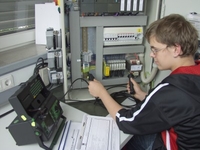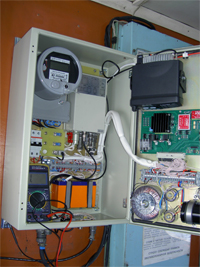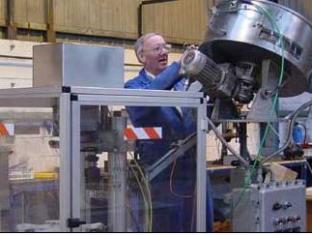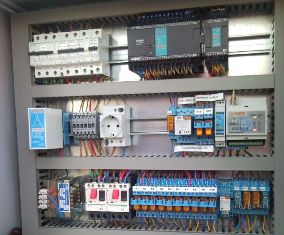Categories: Novice electricians, About electricians and not only
Number of views: 32865
Comments on the article: 0
Profession Adjuster
 The need to establish electrical equipment is not as obvious as, say, the need to mount it. And the results of the adjustment are not so tangible, tangible as during installation. It would seem that it is simpler: apply voltage to the mounted electrical equipment and, by pressing a button, put it into action.
The need to establish electrical equipment is not as obvious as, say, the need to mount it. And the results of the adjustment are not so tangible, tangible as during installation. It would seem that it is simpler: apply voltage to the mounted electrical equipment and, by pressing a button, put it into action.
However, this can only be done in the simplest cases, for example, when lighting is turned on in residential buildings; in the vast majority, electrical circuits after installation are subject to adjustment.
First of all, the electrical equipment must be checked. This is explained by the fact that during the manufacture, transportation and installation of equipment and apparatus, their damage, deviations from the project, latent defects and, finally, just errors, especially when making connections in complex circuits, are possible. If you neglect the check, the result is likely to be a failure in work or a serious accident.
Study of design and technical documentation
In commissioning, the sequence of operations is of great importance. First, they study the design and technical documentation for the electrical equipment of the launch complex, which is usually represented by the capital construction department of the customer enterprise. Then check the completeness of equipment delivery, compliance with its design. At the same time, the adjusters not only get acquainted with the design solutions, but also identify shortcomings and errors of the circuit diagrams and correct wiring diagrams.
The manufacturer’s documentation contains passports of electrical equipment, which provide rating data, design parameters, instructions for turning on and operating, and in some cases, a description of the methodology and devices for testing.
Visual inspection
An external inspection of the equipment is carried out with the recording of the main passport data, defects and deficiencies are detected. All comments on design materials and equipment are reported to the customer. As a rule, the elimination of equipment defects or its replacement is carried out by the customer, and the necessary changes and installation corrections are carried out by the personnel of the wiring organization.
Checking electrical connections
The correct electrical connections are checked "Pby the bell ”. This somewhat jargon term owes its origin to an electric bell, by which the presence of an electrical connection was detected. And although subsequently the call was replaced by a flashlight, the name of the operation remained the same. The device for dialing is commonly called the "probe."
Usually, the correctness of the connections is checked according to the circuit diagram, since errors can crept into the wiring diagram during design.
 It is convenient to check the relay-contact control circuits for signaling according to functional chains, which are located parallel to each other on circuit diagrams. Note that you can not make a call if the circuit is simple and there is reason to hope that the installation is correct. In these cases, the circuit will immediately be tested under voltage, making sure first of all that there are no short circuits and ground. They disconnect the main (otherwise, primary) circuits, that is, power cables and buses, electric motors, converters and other electrical installations that supply electric current.
It is convenient to check the relay-contact control circuits for signaling according to functional chains, which are located parallel to each other on circuit diagrams. Note that you can not make a call if the circuit is simple and there is reason to hope that the installation is correct. In these cases, the circuit will immediately be tested under voltage, making sure first of all that there are no short circuits and ground. They disconnect the main (otherwise, primary) circuits, that is, power cables and buses, electric motors, converters and other electrical installations that supply electric current.
The control, signaling and protection circuits (these are secondary circuits) supply operational voltage through fuses or other protective devices.
In each parallel circuit, “your” electromagnetic device must turn on (or the light in the alarm circuit lights up) if you close all the contacts that are broken in the circuit; they are called make (normally open) contacts.If this does not happen, then either the device itself is faulty (winding breakage, mechanical damage), or there is a break in the circuit due to improper installation, wire breakage, lack of contact in the set of clamps, etc.
The place of the gap can be determined using a portable voltmeter: here it will show the total supply voltage of the circuit.
Interruption of each of the opening (normally closed) contacts connected in series should lead to the disconnection of the device in its circuit.
Measurement of electrical parameters of electrical equipment
The task of checking electrical equipment also includes the measurement of various electrical parameters. Many measurements are typical: they are performed in electrical installations of various purposes.
Typical parameters include voltage, current, power, frequency and phase of alternating current, time, electrical resistance.
Some parameters are typical only for a certain type of electrical installations, and the issues of their measurements are posed together with the adjustment of these installations: for example, measuring the speed, resistance of grounding devices, oscillography, etc.
Overvoltage Insulation Test
So, the electrical equipment and installation are checked for compliance with the project, errors - if they were - are corrected. Can I turn on the installation of the operating voltage in operation? No, not before electrical equipment is tested. The scope and types of tests are governed by the rules, but common to all electrical installations is the insulation test with increased voltage.
Wires, cables are covered with a layer of electrical insulating material, which prevents the electrical contact of the conductive core with other conductors or metal structures (with the housing, with the "ground"). The same function is performed by insulators on which uninsulated busbars are mounted.
The insulation is selected for the operating voltage of the electrical installation "with a margin", it should serve for a long time. Therefore, before switching on, the insulation is subjected to short-term exposure to a voltage several times higher than its operating voltage: it is easier to identify hidden insulation defects that could occur later.

DC insulation measurement
A certain idea of the quality of insulation can be given by its resistance to direct current, measured using a special device - a megohmmeter. Higher electrical insulation resistance, the better it is, of course, in the absence of its hidden defects. A small current that flows through the insulation under the influence of the voltage applied to it (operating or test) is called the leakage current.
When tests are performed on alternating voltage, a component due to the capacity of the test object is added to the leakage current caused by the resistance to direct current and characterizing the strength of the insulation.
Not only does this distort information about the quality of insulation: an increase in current requires a corresponding increase in the power of the test setup, which is completely undesirable. Therefore, extended objects, such as cables, having a significant capacitance relative to the ground, are tested at a constant, or rather, rectified current.
Flowing through the insulation, direct current charges the capacitance and does not reach the steady-state immediately: with dry insulation a few tens of seconds after switching on, with wet insulation it is much faster.
Accepted measure with a megohmmeter insulation resistance after 15 and 60 s after voltage is applied, and its degree of moisture is characterized by the so-called absorption coefficient (absorption - here: moisture absorption by the entire volume of insulation material).
An insulation is considered to have passed the test if: there is no breakdown or overlap of the insulation (strong discharges, gas or smoke, etc.n.), not noticed strong heating of the insulation; leakage current (or insulation resistance) is not within acceptable limits.
Identification of cable damage
If due to any reasons (mechanical damage, dampness, aging) the dielectric strength of the insulation decreases, defective places during high voltage tests are damaged. What then? The porcelain insulators on which the tires are mounted are not repaired and must be replaced. Cables are another matter: replacing a power cable with a voltage higher than 1 kV is completely difficult and expensive, so the damaged area is cut out and the ends are spliced.
But first, it is necessary with sufficient accuracy to locate the place of cable damage. There are various methods and instruments that allow you to measure the distance to the place of damage or indicate it directly. Some methods require that transition resistance the damage site was relatively small. To fulfill this condition, it is often necessary to additionally “burn” the cable using special installations.
Adjustment of control, protection and alarm circuits
When testing, checking control, protection and signaling circuits, it should be borne in mind that the insulation resistance of all circuit elements is connected in parallel. Therefore, even with a sufficiently high insulation resistance of individual elements, the overall insulation resistance of the circuit as a whole can be small.
If the total insulation resistance of the circuit turns out to be lower than 0.5 - 1 MΩ, it is recommended to disassemble the circuit, i.e. disconnect the windings of electromagnetic devices, instruments, measuring transformers, etc., and then measure the insulation resistance of each device and wires and identify elements with reduced insulation .

Adjustment of relay-contactor equipment
The relay-contactor equipment of the circuits is tested in operation at rated and reduced operating voltage. In case of failures, the voltage (current) of the operation of the devices is checked, defects in their assembly and adjustment are found and eliminated.
Adjustment of grounding devices
One of the most important elements of an electrical installation is a grounding device, the purpose of which is to reduce the risk of electric shock if the insulation is damaged. The grounding device consists of grounding conductors and grounding conductors.
Earthing switches are conductors in contact with the ground. Through grounding conductors, grounding parts of electrical equipment, such as metal housings, are connected to them.
First of all, they strive to use natural grounding conductors (reinforced concrete foundations, metal structures, etc.). As artificial grounding, steel rods or angle steel are used. Clogged into the ground at a certain distance from each other and connected by a steel strip, they form a ground loop in electrical installations up to 1 kV with a dead-grounded neutral of the body of electrical equipment connected to the neutral of the supply transformer.
When the network phase is shorted to the housing, a single-phase short circuit (the so-called phase-zero circuit) is formed: phase of the transformer - phase wire - neutral wire - neutral of the transformer.
Under the influence of a short circuit current, the power receiver must quickly disconnect from the network with the nearest protection device - a circuit breaker or fuse. Reliability, the speed of operation of the apparatus will be the higher, the greater the shut-off current, that is, the lower the resistance of the phase zero circuit.
During commissioning, the reliability of the connections for the grounding conductors is checked, the resistance of the grounding device, the resistance of the phase-zero circuit are measured.
Primary current test
Among the tests common to various electrical installations is primary current testing.These tests are carried out to test secondary current circuits and maximum protection devices, which turn off the electrical installation in the event of an accident, at currents that are much higher than the operating values.
The primary circuits have very little resistance, so the load devices used to supply test current to these circuits can be run on a small output voltage of the order of several volts and, therefore, on a relatively small power. Usually, step-down transformers with a high transformation ratio are used for this purpose, which allow to obtain a load current of up to several thousand amperes.

Electrical setup
Finally, the adjustment of electrical equipment and apparatus. This is perhaps the most difficult, sometimes the most time-consuming part of the adjustment technology. Its purpose is to ensure the correct interaction and reliable operation of production equipment.
It is necessary to carefully configure the equipment and elements of control circuits in operating modes, to ensure the correct operation of interlocks and sensors of electrical and technological parameters, as well as the reliable joint operation of centralized and local automation systems.
Accidents in electrical installations are fraught with serious consequences not only for the electrical equipment itself, but also for production, and most importantly for people. To prevent an accident or, at least, to minimize the possible consequences - this task is performed by protective electrical equipment.
To successfully complete this task, protection must be properly configured. This means that the protective device must work reliably with the parameter value that is typical for this type of accident: for example, if a short circuit occurs at the motor terminals, it must be disconnected by the nearest maximum protection device, which at the same time should not be triggered by the starting currents of the motor.
After the electrical equipment has been tested, tested and set up, it can be energized, but it is too early to put it into operation: electrical installations must be tested under load. Indeed, during preliminary tests, some modes had to be simulated or created artificially, while others can only be checked according to the working scheme. At this stage, a comprehensive testing of electrical equipment is carried out and, finally, its delivery to the customer.
See also at bgv.electricianexp.com
:
